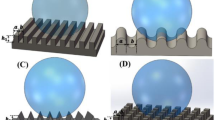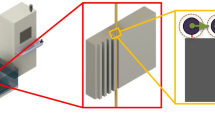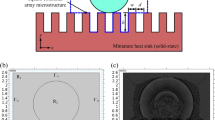Abstract
To address the problems of high process complexity, uncontrollable and unpredictable wetting performance, and expensive processing equipment for the superhydrophobic surfaces of metal substrates prepared by conventional methods, in this paper, superhydrophobic surfaces consisting of rectangular cross-section double-scale arrays of microstructure were prepared on HT250 substrates using wire electrical discharge machining (WEDM). First, a simulation model of the surface wetting performance of the rectangular cross-section double-scale array microstructure prepared by WEDM is established, to analyze the effect of peak current and pulse width on the surface roughness, dimensional parameters, and surface wetting performance of the discharge micro-crater structure; the effect of the width and distance of the rectangular cross-section on the surface wetting performance of the double-scale array of microstructure with rectangular cross-section is further discussed. And the simulation model is experimentally verified. The results of the study in this paper indicate that at a peak current of 12A, a pulse width of 20 μs, and a rectangular cross-section with a width and distance of 200 μm, the contact angles of the rectangular cross-section double-scale array microstructure surface obtained from simulation and experiment are 133° and 135.3°, respectively, the prediction accuracy of the simulation model is 98.3%, and the surface has superhydrophobic performance after low surface energy treatment, with a static contact angle of 151.5°. This study not only extends the application area of WEDM, but also provides a theoretical reference for the design of metal substrate microstructure surface, realizes the controllable preparation and accurate prediction of wetting performance of metal substrate microstructure surface, and has important guiding significance for the preparation of metal substrate superhydrophobic surfaces.
Graphical abstract










Similar content being viewed by others
Data availability
Data is contained within the article.
Abbreviations
- W :
-
Width of rectangular cross-section (μm)
- L :
-
Distance of rectangular cross-section (μm)
- h :
-
Depth of a single discharge micro-crater (μm)
- r :
-
Radius of a single discharge micro-crater (μm)
- h a :
-
Height of the raised structure relative to the bottom (μm)
- a :
-
Diameter of the raised structure (μm)
- r s :
-
Remaining radius after superposition of single discharge micro-crater (μm)
- b :
-
Distance between two raised structures (μm)
- h b :
-
Height of the highest point of the remaining part of a single discharge micro-crater after superimposition from its bottom (μm)
- Ra :
-
Surface roughness of discharge micro-crater structure (μm)
- θ c :
-
Contact angle of the surface of a discharge micro-crater structure in the Cassie wetting state (°)
- f 1 :
-
Solid-liquid contact area on the surface of the discharge micro-crater structure as a fraction of the actual contact area of the liquid droplet
- θ 0 :
-
Intrinsic contact angle of the substrate surface (°)
- ρ :
-
Density of the fluid (Kg/m3)
- u :
-
Flow rate of fluid (m/s)
- P :
-
Pressure of the fluid (Pa)
- I :
-
Unit Matrix
- μ :
-
Dynamic viscosity of the fluid (kg/m/s)
- T :
-
Temperature of the fluid (K)
- F :
-
Volumetric force source term (N)
- ϕ :
-
Phase-field variables
- ε :
-
Interface thickness control parameters (m)
- ψ :
-
Phase-field auxiliary variables
- σ :
-
Surface tension coefficient (mN/m)
- λ :
-
Hybrid energy density (J/m3)
- ρ 1 :
-
Density of air (Kg/m3)
- ρ 2 :
-
Density of water (Kg/m3)
- μ 1 :
-
Dynamic viscosity of air (kg/m/s)
- μ 2 :
-
Dynamic viscosity of water (kg/m/s)
- V f 1 :
-
Volume fraction of air
- V f 2 :
-
Volume fraction of water
- θ c ' :
-
Contact angle of rectangular cross-section double-scale array microstructure surface in the Cassie wetting state (°)
- f 1 ' :
-
The share of the solid–liquid contact area on the surface of the microstructure array with rectangular cross-section in the actual contact area of the liquid droplet
References
Hegner KI, Wong WSY, Vollmer D (2021) Ultrafast bubble bursting by superamphiphobic coatings. Adv Mater 33:2101855. https://doi.org/10.1002/adma.202101855
Boinovich LB, Modin EB, Sayfutdinova AR, Emelyanenko KA, Vasiliev AL, Emelyanenko AM (2017) Combination of functional nanoengineering and nanosecond laser texturing for design of superhydrophobic aluminum alloy with exceptional mechanical and chemical properties. ACS Nano 11(10):10113–10123. https://doi.org/10.1021/acsnano.7b04634
Liu T, Kim CJ (2014) Turning a surface superrepellent even to completely wetting liquids. Science 346(6213):1096–1100. https://doi.org/10.1126/science.1254787
Fu K, Lu C, Liu YB, Zhang H, Zhang BL, Zhang HP, Zhou FT, Zhang QY, Zhu BL (2021) Mechanically robust, self-healing superhydrophobic anti-icing coatings based on a novel fluorinated polyurethane synthesized by a two-step thiol click reaction. Chem Eng J 404:127110. https://doi.org/10.1016/j.cej.2020.127110
Chu Y, Qin LM, Zhen L, Pan QM (2018) Controlled movement of a smart miniature submarine at various interfaces. ACS Appl Mater Interfaces 10(29):24899–24904. https://doi.org/10.1021/acsami.8b06631
Schutzius TM, Jung S, Maitra T, Graeber G, Kohme M, Poulikakos D (2015) Spontaneous droplet trampolining on rigid superhydrophobic surfaces. Nature 527(7576):82–85. https://doi.org/10.1038/nature15738
Zhou QT, Thokchom AK, Kim DJ, Kim T (2017) Inkjet-printed Ag micro-/nanostructure clusters on Cu substrates for in-situ pre-concentration and surface-enhanced Raman scattering. Sens Actuators B Chem 243:176–183. https://doi.org/10.1016/j.snb.2016.11.134
Nuss P, Harper EM, Nassar NT, Reck BK, Graedel TE (2014) Criticality of iron and its principal alloying elements. Environ Sci Technol 48(7):4171–4177. https://doi.org/10.1021/es405044w
Liu T, Yin YS, Chen SG, Chang XT, Cheng S (2007) Super-hydrophobic surfaces improve corrosion resistance of copper in seawater. Electrochim Acta 52(11):3709–3713. https://doi.org/10.1016/j.electacta.2006.10.059
Daniello RJ, Waterhouse NE, Rothstein JP (2009) Drag reduction in turbulent flows over superhydrophobic surfaces. Phys Fluids 21(8):085103. https://doi.org/10.1063/1.3207885
Hou WQ, Shen YZ, Tao J, Xu YJ, Jiang JW, Chen HF, Jia ZF (2020) Anti-icing performance of the superhydrophobic surface with micro-cubic array structures fabricated by plasma etching. Colloids Surf A: Physicochem Eng Asp 586:124180. https://doi.org/10.1016/j.colsurfa.2019.124180
Wang DH, Sun QQ, Hokkanen MJ, Zhang CL, Lin FY, Liu Q, Zhu SP, Zhou TF, Chang Q, He B, Zhou Q, Chen LQ, Wang ZK, Ras RHA, Deng X (2020) Design of robust superhydrophobic surfaces. Nature 582:55–59. https://doi.org/10.1038/s41586-020-2331-8
Yeganeh M, Mohammadi N (2018) Superhydrophobic surface of Mg alloys: a review. J Magnes Alloys 6(1):59–70. https://doi.org/10.1016/j.jma.2018.02.001
Sun YK, Liu JY, Ming PM, Zhao DY, Song JL (2022) Wire electrochemical etching of superhydrophobic 304 stainless steel surfaces based on high local current density with neutral electrolyte. Appl Surf Sci 571:151269. https://doi.org/10.1016/j.apsusc.2021.151269
Tuo YJ, Zhang HF, Rong WT, Jiang SY, Chen WP, Liu XW (2019) Drag reduction of anisotropic superhydrophobic surfaces prepared by laser etching. Langmuir 35(34):11016–11022. https://doi.org/10.1021/acs.langmuir.9b01040
Zheng TX, Hu YB, Pan FS, Zhang YX, Tang AT (2019) Fabrication of corrosion-resistant superhydrophobic coating on magnesium alloy by one-step electrodeposition method. J Magnes Alloys 7(2):193–202. https://doi.org/10.1016/j.jma.2019.05.006
Li J, Wang Y, Gao RX, Zhang TC, Yuan SJ (2022) Superhydrophobic copper foam modified with hierarchical stearic acid/CuSiO3/Cu(OH)2 nanocomposites for efficient water/oil separation. J Enviro Chem Eng 10(3):107618. https://doi.org/10.1016/j.jece.2022.107618
Li LJ, Li X, Chen JL, Liu L, Lei JL, Li NB, Liu G, Pan FS (2021) One-step spraying method to construct superhydrophobic magnesium surface with extraordinary robustness and multi-functions. J Magnes Alloys 9(2):668–675. https://doi.org/10.1016/j.jma.2020.06.017
Zhao WY, Zhu RJ, Jiang JY, Wang ZM (2019) Environmentally-friendly superhydrophobic surface based on Al2O3@KH560@SiO2 electrokinetic nanoparticle for long-term anti-corrosion in sea water. Appl Surf Sci 484:307–316. https://doi.org/10.1016/j.apsusc.2019.04.012
Jiang SQ, Li WD, Liu JY, Jiang JQ, Zhang Z, Shang W, Peng N, Wen YQ (2022) ZnO@ZIF-8 core-shell structure nanorods superhydrophobic coating on magnesium alloy with corrosion resistance and self-cleaning. J Magnes Alloys. https://doi.org/10.1016/j.jma.2022.01.014
Yang C, Zeng QH, Huang JX, Guo ZG (2022) Droplet manipulation on superhydrophobic surfaces based on external stimulation: a review. Adv Colloid Interf Sci 306:102724. https://doi.org/10.1016/j.cis.2022.102724
Wang H, Chi GX, Wang YK, Yu FX, Wang ZL (2019) Fabrication of superhydrophobic metallic surface on the electrical discharge machining basement. Appl Surf Sci 478:110–118. https://doi.org/10.1016/j.apsusc.2019.01.102
Gamage JR, DeSilva AKM, Chantzis D, Antar M (2017) Sustainable machining: process energy optimisation of wire electrodischarge machining of Inconel and titanium superalloys. J Clean Product 164: 642–651. https://doi.org/10.1016/j.jclepro.2017.06.186
Wan YL, Lou J, Yu ZJ, Li XZ, Yu HD (2014) Single-step fabrication of bionic-superhydrophobic surface using reciprocating-type high-speed wire cut electrical discharge machining. Chin Sci Bull 59:3691–3695. https://doi.org/10.1007/s11434-014-0524-y
Bae WG, Song KY, Rahmawan Y, Chu CN, Kim D, Chung DK, Suh KY (2012) One-step process for superhydrophobic metallic surfaces by wire electrical discharge machining. ACS Appl Mater Interfaces 4(7):3685–3691. https://doi.org/10.1021/am3007802
Xing L, Zhang QX, Zhang LT, Huang XJ, Liu C, He XQ, Zhou L (2022) Controllable preparation of wear-resistant superhydrophobic surfaces fabricated with square column microstructures. Mater Lett 309:131468. https://doi.org/10.1016/j.matlet.2021.131468
Liang YH, Peng J, Li XJ, Huang JB, Qiu RX, Zhang ZH, Ren LQ (2017) Wettability and contact time on a biomimetic superhydrophobic surface. Materials 10(3):254. https://doi.org/10.3390/ma10030254
Chen Z, Yan ZJ, Zhou HB, Han FL, Zhao LH, Yan HZ (2021) One-step fabrication of the wear-resistant superhydrophobic structure on SiCp/Al composite surface by WEDM. Surf Coatings Technol 409:126876. https://doi.org/10.1016/j.surfcoat.2021.126876
Zhou CL, Wu XY, Lu YJ, Wu W, Zhao H, Li LJ (2018) Fabrication of hydrophobic Ti3SiC2 surface with micro-grooved structures by wire electrical discharge machining. Ceram Int 44(15):18227–18234. https://doi.org/10.1016/j.ceramint.2018.07.032
Zhang YH, Yang X, Wang SJ, Liu JY, Liu X, Chan KC, Liu JW (2023) Multifunctional superhydrophobic copper mesh for efficient oil/water separation and fog collection. Colloids Surf A: Physicochem Eng Asp 657 Part A 130603. https://doi.org/10.1016/j.colsurfa.2022.130603
Hosseini S, Savaloni H, Shahraki MG (2019) Influence of surface morphology and nano-structure on hydrophobicity: a molecular dynamics approach. Appl Surf Sci 485:536–546. https://doi.org/10.1016/j.apsusc.2019.04.236
Wang PY, He L, Wang ZQ (2021) The effect of surface structure and arrangement on wettability of substrate surface. Colloids Surf A: Physicochem Eng Asp 614:126165. https://doi.org/10.1016/j.colsurfa.2021.126165
Cai ZR, Song YL (2021) Implementing contact angle hysteresis in moving mesh-based two-phase flow numerical simulations. ACS Omega 6(51):35711–35717. https://doi.org/10.1021/acsomega.1c05613
Gong W, Yan YY, Chen S, Giddings D (2017) Numerical study of wetting transitions on biomimetic surfaces using a lattice Boltzmann approach with large density ratio. J Bionic Eng 14:486–496. https://doi.org/10.1016/S1672-6529(16)60414-6
Li C, Zhang J, Han J, Yao BH (2021) A numerical solution to the effects of surface roughness on water-coal contact angle. Sci Rep 11:459. https://doi.org/10.1038/s41598-020-80729-9
Li ZL, Liu YT, Cao BR, Li WW (2022) Modeling of material removal morphology and prediction of surface roughness based on WEDM successive discharges. Int J Adv Manuf Technol 120:2015–2029. https://doi.org/10.1007/s00170-022-08870-5
Salonitis K, Stournaras A, Stavropoulos P, Chryssolouris G (2009) Thermal modeling of the material removal rate and surface roughness for die-sinking EDM. Int J Adv Manuf Technol 40:316–323. https://doi.org/10.1007/s00170-007-1327-y
Dong SL. Research on micro-EDM and its superhydrophobic property of bertllium copper alloy. Harbin Institute of Technology (Doctoral Dissertation 2018)
Chen Z, Zhou HB, Yan ZJ, Han FL, Yan HZ (2021) A new high-speed observation system for evaluating the spark location in WEDM of Inconel 718. J Market Res 13:184–196. https://doi.org/10.1016/j.jmrt.2021.04.064
Funding
This work was supported by the Supported by Opening Project of the Key Laboratory of Advanced Manufacturing and Intelligent Technology (Ministry of Education), grant number: KFKT202204, and National Natural Science Foundation of China, grant number: 52075134.
Author information
Authors and Affiliations
Contributions
Zhaolong Li: conceptualization, methodology, software. Wangwang Li: data curation, writing—original draft preparation. Yingtao Liu: visualization, investigation. Meng Xun: supervision, software. Mengchen Yuan: writing—reviewing and editing. All authors commented on previous versions of the manuscript. All authors read and approved the final manuscript.
Corresponding author
Ethics declarations
Conflict of interest
The authors declare no competing interests.
Additional information
Publisher's note
Springer Nature remains neutral with regard to jurisdictional claims in published maps and institutional affiliations.
Rights and permissions
Springer Nature or its licensor (e.g. a society or other partner) holds exclusive rights to this article under a publishing agreement with the author(s) or other rightsholder(s); author self-archiving of the accepted manuscript version of this article is solely governed by the terms of such publishing agreement and applicable law.
About this article
Cite this article
Li, Z., Li, W., Liu, Y. et al. Simulation and experiment of WEDM double-scale array microstructure surface wetting performance. Int J Adv Manuf Technol 126, 3205–3218 (2023). https://doi.org/10.1007/s00170-023-11331-2
Received:
Accepted:
Published:
Issue Date:
DOI: https://doi.org/10.1007/s00170-023-11331-2




